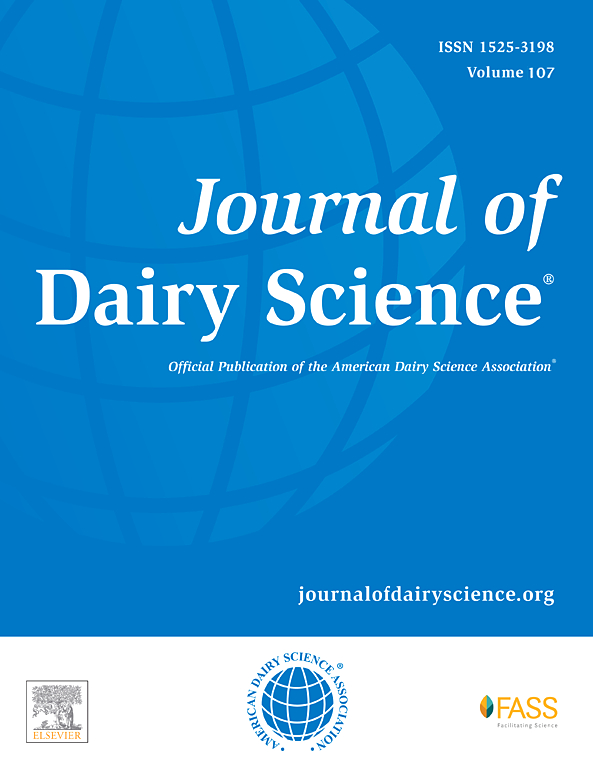别忘了母牛奶牛与小牛接触 3 个月后对两种分离方法的反应。
IF 4.4
1区 农林科学
Q1 AGRICULTURE, DAIRY & ANIMAL SCIENCE
引用次数: 0
摘要
断奶和分离仍然是奶牛-犊牛接触系统面临的最大挑战之一,因此,开发实用的低应激分离方法对这些系统未来的成功至关重要。本研究旨在比较奶牛在与犊牛全时接触3个月后对分离犊牛的行为和生理反应,可采用两步法(NF,全时接触2周,犊牛佩戴鼻翼,完全分离前围栏接触1周,n = 18)或逐步减少奶牛与犊牛的接触时间(GR,半天接触1周,上午接触1周,完全分离前围栏接触1周,n = 18)。从分离前 1 周到完全分离后 1 周,每周 4 天观察母牛的发声和搜寻行为。在此期间,通过加速度计和压力传感器自动评估卧地行为和反刍时间。从分离开始的第1天到第23天,每周收集两次粪便和血液样本,用于分析粪便皮质醇代谢物和免疫反应。连续记录挤奶厅的产奶量。采用线性混合效应模型进行统计分析。我们发现,两种分离方法在行为和生理反应变量方面均无差异。但是,与基线相比,两种方法都会使发声和搜索行为明显增加。此外,生理痛苦指标也有短暂的增加,并且在开始处理时产奶量也有短暂的保持,这表明两种方法都会引起奶牛的痛苦。从描述性角度看,奶牛个体间差异很大,行为反应发生的时间分布也不同,GR奶牛在接触围栏线的一周内和与犊牛完全分离后发声最频繁,而NF奶牛在犊牛佩戴鼻翼的两周内反应最强烈。在GR犊牛与母牛接触时间受限和NF犊牛不能哺乳的2周内,NF奶牛的产奶量高于GR奶牛,但之后就没有差别了。然而,GR奶牛在半日接触和上午接触的几周内的晚间产奶量相似,这表明每周接触时间的减少是逐步进行的,而不是渐进式的,这就需要进一步改进GR方法。总之,结果表明,在分 3 周、分 3 个步骤实施 GR 法和 NF 法的情况下,奶牛在分离过程中会感到不安,但个体之间的差异很大。本文章由计算机程序翻译,如有差异,请以英文原文为准。
Dairy cows' responses to 2 separation methods after 3 months of cow-calf contact
Weaning and separation remain among some of the biggest challenges for cow-calf contact systems, making the development of practical and low-stress separation methods mandatory for future success of these systems. This study aimed to compare behavioral and physiological responses of dairy cows to separation from their calves after 3 mo of full-time contact, with either the 2-step method (NF, 2 wks full-time contact while calves wore a nose flap, 1 wk fence-line contact before total separation, n = 18) or by gradual reduction of contact time between cow and calf (GR, 1 wk half day contact, 1 wk morning contact, 1 wk fence-line contact before total separation, n = 18). Vocalizations and searching behavior were observed on 4 d/wk from 1 wk before separation until 1 wk after total separation. During the same period, lying behavior and rumination time was automatically assessed via accelerometers and pressure sensors. Fecal and blood samples were collected twice per week from day −1 until +23 relative to separation start for analysis of fecal cortisol metabolites and the immune response. Milk yield in the parlor was continuously recorded. Statistical analysis was conducted using linear mixed effects models. We found no difference between the 2 separation methods in any of the examined behavioral and physiological response variables. However, a significant increase in vocalizations and searching behavior compared with baseline was present with both methods. Furthermore, there was a transient increase in physiological distress markers and a short-lived retention of milk yield at initiation of treatments, indicating that both methods induced distress for the cows. Descriptively, there were large interindividual differences between cows as well as a different temporal distribution in occurrence of behavioral responses, as GR cows vocalized most frequently during the week with fence-line contact and after total separation from the calf, while NF cows reacted strongest during the 2 wk while calves wore the nose flap. Milk yield was higher in NF than GR cows during the 2 wk while GR calves had time-restricted access to their dams and NF calves were prevented from suckling, but showed no difference afterward. However, similar evening milk yields of GR cows in the weeks with half-day and morning contact, indicated that the weekly reductions in contact time worked in a rather stepwise than gradual manner, which warrants further improvement of the GR method. Taken together, results showed that cows experienced distress during separation with the GR method, when implemented over 3 wk in 3 steps, as well as with the NF method, but differences between individuals were considerable.
求助全文
通过发布文献求助,成功后即可免费获取论文全文。
去求助
来源期刊

Journal of Dairy Science
农林科学-奶制品与动物科学
CiteScore
7.90
自引率
17.10%
发文量
784
审稿时长
4.2 months
期刊介绍:
The official journal of the American Dairy Science Association®, Journal of Dairy Science® (JDS) is the leading peer-reviewed general dairy research journal in the world. JDS readers represent education, industry, and government agencies in more than 70 countries with interests in biochemistry, breeding, economics, engineering, environment, food science, genetics, microbiology, nutrition, pathology, physiology, processing, public health, quality assurance, and sanitation.
 求助内容:
求助内容: 应助结果提醒方式:
应助结果提醒方式:


